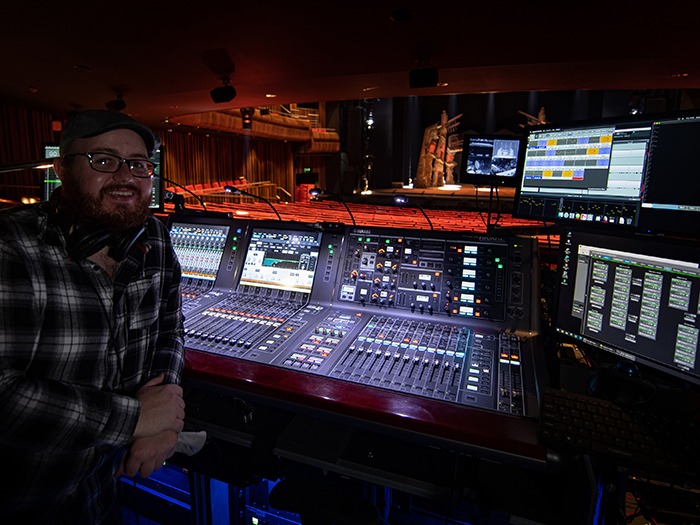Compared with some of Disney’s classic musical films, Bedknobs and Broomsticks has been comparatively late in being adapted as a stage musical. Now the story of three wartime evacuees and their fantasy adventures has made it to theatres in a world premiere tour of the UK and Ireland. Sound Designer, Gareth Fry chose a Yamaha RIVAGE PM10 digital mixing system to bring the magic to life.
The multi- Olivier and Tony award-winning sound designer of Harry Potter And The Cursed Child, The Cat In The Hat, The Encounter, Black Watch and many more shows and exhibitions, Gareth has been keenly watching the development of Yamaha’s RIVAGE PM series digital mixing systems since he attended the 2014 RIVAGE PM10 launch in Tokyo. With the implementation of key theatre features in a free firmware update last year, he was now more than happy to specify it for a touring production.
“There were many good things about RIVAGE PM but, before the addition of the extra theatre functionality, it was tricky to use on a long-running show.” he said. “But now it has everything you need, especially for musicals, and it’s very user friendly for a touring production that changes venues every week.”
Gareth and Production Sound Engineer, Tom Lishman began prepping for the tour in May, which began in Newcastle in mid-August. The tour takes in 27 towns and cities, playing through to May 2022. Apart from a month in Leeds over Christmas, the show is in a new location every week, finishing on Sunday, then opening on Tuesday night in the next venue.
“It’s a very tight schedule for setting up and soundchecking, with different acoustics, system elements in different positions and a lot of things that have to happen in a very short space of time,” he said.
The show features a 12 piece orchestra and 24 radio microphones across the cast. There are 64 channels of live music, with 16 further channels of playback, plus a number of reverb and other effects channels. The musicians all use personal monitors, with a lot of the mix outputs dedicated to them. Almost all the system’s 72 mixes are in use, plus 16 matrix outputs.
“Obviously reliability is critical – and Yamaha’s reliability is exceptional – but one of the advantages for us is that you can have two people working independently on the control surface,” said Fry. “Indeed, there have been times when two are on the PM10 and a third on the StageMix iPad app, all doing different things at the same time. This means that Tom and myself can be making adjustments to the mics and the speaker system, whilst Charles Parry, our No.1 can mix the show without interruption.
“As a sound designer, the ability to wander round the auditorium, stage or orchestra pit with high quality control via StageMix also enables me to build a greater level of trust and confidence with the performers and musicians,” Fry added. “We’re playing to full houses, it’s the first show I’ve done since the pandemic began that hasn’t had socially-distanced audiences. However, once the house opens, nobody at Front of House can go backstage, or vice versa. Another advantage of the StageMix app is that it allows some control of the desk from the stage. It gives us exactly the sort of flexibility we need.”
He continued: “One of the key elements of the RIVAGE PM operating system is that it allows you to choose an actor and programme them into the show. If one of the principal cast is off sick, somebody else will step in to that role, and often someone else will also move to cover that person’s role. So, if one person is off, two or more people may change which roles they might perform, which is something we are seeing more of in the COVID-19 era. Previously we would have to reprogramme the entire console with different EQs, gain settings, dynamics settings for every scene those performers are in – it was a long and convoluted process, made all the more difficult if you were only told half an hour before the show starts, or if someone is injured mid-show. The new software update to the RIVAGE PM operating system allows you to map a performer to a role very quickly and in a straightforward way. You can immediately see what’s going on, making you less prone to programming mistakes.”
As well as RIVAGE PM10, Gareth is using Yamaha MRX7-D signal processors on Bedknobs and Broomsticks. They also form an important part of several productions of Harry Potter and the Cursed Child. “The MRX7-D has been one of my standard tools for a few years. It’s used as the main processing system for the speakers, managing all relative levels, all EQs, delay matrixing and all the odd bits of routing to do quirky little solutions that you often need with live performance,” he said.
Back at the console, his first production using the RIVAGE PM10 system is proving an unqualified success. “I’m super happy with it. It sounds lovely, the Bricasti reverb improves the sound even further and the surface is really intuitive to use,” he explained. “There’s a really good design thread that runs through all Yamaha digital mixers. If you can use a QL1, it only takes you about 15 minutes to adapt to the top of range system. Almost everyone has experience of Yamaha, so it was a very easy process for us to learn the RIVAGE PM10. Both Charles, and our No.2/Mix cover Samantha Mullis, have adapted to it very quickly. It feels very familiar and has really speeded up the pace we can work at.
Fry concluded: “Harry Potter and the Cursed Child opens in Tokyo next year and, where previously we’ve used two mixing consoles to separately deal with the playback and reinforcement duties, we’re now looking at consolidating that down to one RIVAGE PM5.”


